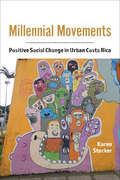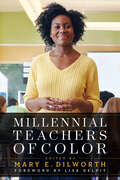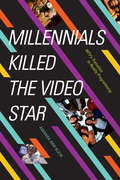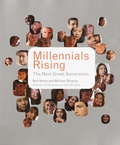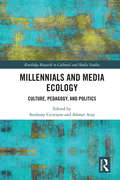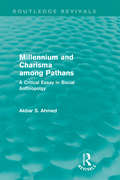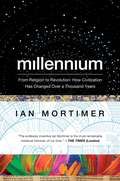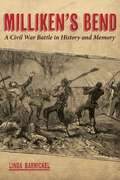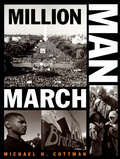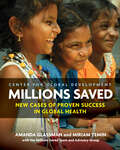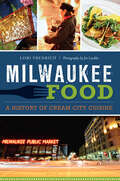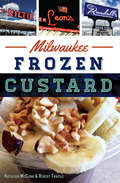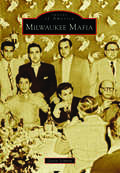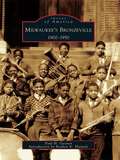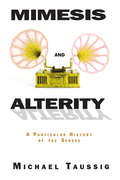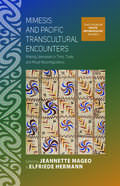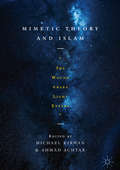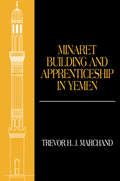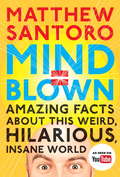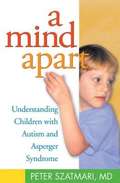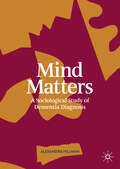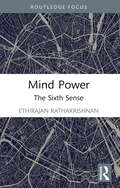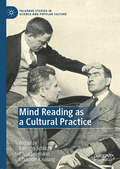- Table View
- List View
Millennial Movements: Positive Social Change in Urban Costa Rica (Teaching Culture: UTP Ethnographies for the Classroom)
by Karen StockerThrough social movements that are both grassroots and global, young leaders in San José, Costa Rica, have sought to create positive social change in their communities. Using social media, art, local organizations, corporations, and government entities, these leaders have found creative ways to connect with and support one another’s efforts to promote change and tackle growing concerns, including environmental sustainability, freedom from sexual assault, food security, LGBTQ+ rights, and more. Presenting case studies of Costa Rican millennial leaders, Millennial Movements shows how youth activists in San José draw from global solutions to address the local problems inhabiting their city. Identifying with the youths that they encounter in each chapter, students will be inspired by the strategies and skills used by these leaders and can adapt them to their own schools and communities.
Millennial Teachers of Color (Race and Education)
by Mary E. Dilworth2019 Outstanding Book Award, American Association of Colleges for Teacher Education (AACTE)Millennial Teachers of Color explores the opportunities and challenges for creating and sustaining a healthy teaching force in the United States. Millennials are the largest generational cohort in American history, with approximately ninety million members and, of these, roughly 43 percent are people of color. This book, edited by prominent teacher educator Mary E. Dilworth, considers the unique qualities, challenges, and opportunities posed by that large population for the teaching field. Noting that a diverse teaching and learning community enhances student achievement, particularly for the underserved and underachieving preK–12 student population, Dilworth argues that efforts to recruit, groom, and retain teachers of color are out-of-date and inadequate. She and the contributors offer fresh looks at these millennials and explore their views of the teaching profession; focus attention on their relation to schools and teaching; and consider how these young teachers feel about teaching for social justice. The book is intended to disrupt the current line of inquiry that suggests that by simply increasing the number of teachers of color equity has been established. Readers will gain insights on this unique and valuable group of prospective and practicing preK–12 educators and understanding of the need for more contemporary approaches to recruitment, preparation, hiring, and placement.Contributors Keffrelyn D. BrownKeith C. CatoneGenesis A. ChavezMarcus J. ColemanHollee R. FreemanMichael HansenSocorro G. HerreraSarah IshmaelSabrina Hope KingAdam T. Kuranishi Lindsay A. MillerAmanda R. MoralesJanice Hamilton OuttzZollie Stevenson Jr.Dulari TahbildarAngela M. Ward
Millennials Killed the Video Star: MTV's Transition to Reality Programming
by Amanda Ann KleinBetween 1995 and 2000, the number of music videos airing on MTV dropped by 36 percent. As an alternative to the twenty-four-hour video jukebox the channel had offered during its early years, MTV created an original cycle of scripted reality shows, including Laguna Beach, The Hills, The City, Catfish, and Jersey Shore, which were aimed at predominantly white youth audiences. In Millennials Killed the Video Star Amanda Ann Klein examines the historical, cultural, and industrial factors leading to MTV's shift away from music videos to reality programming in the early 2000s and 2010s. Drawing on interviews with industry workers from programs such as The Real World and Teen Mom, Klein demonstrates how MTV generated a coherent discourse on youth and identity by intentionally leveraging stereotypes about race, ethnicity, gender, and class. Klein explores how this production cycle, which showcased a variety of ways of being in the world, has played a role in identity construction in contemporary youth culture—ultimately shaping the ways in which Millennial audiences of the 2000s thought about, talked about, and embraced a variety of identities.
Millennials Rising: The Next Great Generation
by William Strauss Neil HoweBy the authors of the bestselling 13th Gen, the first in-depth examination of the Millennials--the generation born after 1982. "Over the next decade, the Millennial Generation will entirely recast the image of youth from downbeat and alienated to upbeat and engaged--with potentially seismic consequences for America." --from Millennials Rising. In this remarkable account, certain to stir the interest of educators, counselors, parents, and people in all types of business as well as young people themselves, Neil Howe and William Strauss introduce the nation to a powerful new generation: the Millennials. They will also explain: Why today's teens are smart, well-behaved, and optimistic, and why you won't hear older people say that. Why they get along so well with their Boomer and Xer parents. Why Millennial collegians will bring a new youth revolution to America's campuses. Why names like "Generation Y" and "Echo Boom" just don't work for today's kids. Having looked at oceans of data, taken their own polls, and talked to hundreds of kids, parents, and teachers, Howe and Strauss explain how Millennials are turning out to be so dramatically different from Xers and boomers and how, in time, they will become the next great generation.
Millennials and Media Ecology: Culture, Pedagogy, and Politics (Routledge Research in Cultural and Media Studies)
by Ahmet Atay Anthony CristianoMillennials and Media Ecology explores issues pertaining to millennials and digital media ecology and studies the cultural, pedagogical, and political environments such heterogeneous generation populates. The book questions whether millennials are properly understood as a heterogeneous group, particularly by the institutions and agencies that target them, and whether they are demonstrating the ability to set out a path for themselves and take charge of their own life and future. A diverse team of expert authors review past and current studies with critical assessment of arguments and propositions, and document actual experiences of members of the millennial generation through detailed studies. Engaging with topical subject matter and current research on millennials, the chapters: Question the misunderstanding that digital tools and Internet technologies are making the younger generation ‘dumber’ and ‘disengaging’ them from the real world Underscore the legal and economic insights into the commodification of the younger generation as consumers rather than learners Examine the historical trajectory of media technology, and whether new practices are having an empowering effect or one of enslavement to an increasingly irreversible technological and socio-political regime Shed light on issues of critical pedagogy emerging from digital environments in relation to one’s mental abilities and degrees of wisdom Discuss the cultural and political implications of millennials’ new media trends, the changing relationship between millennials and legacy media, which rely on the younger generation for survival;Offer new insights into the significance of current media trends in relation to issue of credibility and identity. This is an essential book for scholars in the fields of Media and Communications and Popular Culture, and will be vital reading for postgraduate students and specialists in related fields.
Millennium and Charisma Among Pathans: A Critical Essay in Social Anthropology (Routledge Revivals)
by Akbar AhmedFirst published in 1976, this Routledge Revivals reissue presents an analysis of the Swat Pathans, the people of the North-West Frontier Province of Pakistan, who belong administratively to Pakistan despite being a fiercely independent group, with their own codes and ways of life. Akbar S. Ahmed, who knows the Swat Pathans well through his family connections, presents a clear and sophisticated analysis of their complex society. The study provides an anthropological and critical re-examination of the ethnography of the Swat Pathans and the author suggests specific alternative models of social organization. The book also represents an important contribution to the general debate in the social sciences between the ‘methodological individualists’ and the ‘methodological holists’, and challenges some of the theoretical and methodological premises in anthropology. In particular the author is critical of Professor Fredrik Barth’s study of Swat Pathans, for he believes that the ‘Swat models’ have inadvertently become the basis for generalized, and often incorrect, understanding of models of Pathan socio-political organization in the social sciences.
Millennium, Messiahs, and Mayhem: Contemporary Apocalyptic Movements
by Thomas Robbins Susan J. PalmerFirst Published in 1997. Routledge is an imprint of Taylor & Francis, an informa company.
Millennium: How Civilization Has Changed Over a Thousand Years
by Ian MortimerHistory's greatest tour guide, Ian Mortimer, takes us on an eye-opening and expansive journey through the last millennium of human innovation. In Millennium, bestselling historian Ian Mortimer takes the reader on a whirlwind tour of the last ten centuries of Western history. It is a journey into a past vividly brought to life and bursting with ideas, that pits one century against another in his quest to measure which century saw the greatest change. We journey from a time when there was a fair chance of your village being burned to the ground by invaders -- and dried human dung was a recommended cure for cancer -- to a world in which explorers sailed into the unknown and civilizations came into conflict with each other on an epic scale. Here is a story of godly scientists, fearless adventurers, cold-hearted entrepreneurs, and strong-minded women -- a story of discovery, invention, revolution, and cataclysmic shifts in perspective. Millennium is a journey into the past like no other. Our understanding of human development will never be the same again, and the lessons we learn along the way are profound ones for us all.
Milliken's Bend: A Civil War Battle in History and Memory
by Linda BarnickelAt Milliken's Bend, Louisiana, a Union force composed predominantly of former slaves met their Confederate adversaries in one of the bloodiest engagements of the war. This small yet important fight received some initial widespread attention but soon drifted into obscurity. In Milliken's Bend, Linda Barnickel uncovers the story of this long-forgotten and highly controversial battle.The fighting at Milliken's Bend occurred in June 1863, about fifteen miles north of Vicksburg on the west bank of the Mississippi River, where a brigade of Texas Confederates attacked a Federal outpost. Most of the Union defenders had been slaves less than two months before. The new African American recruits fought well, despite their minimal training, and Milliken's Bend helped prove to a skeptical northern public that black men were indeed fit for combat duty. After the battle, accusations swirled that Confederates had executed some prisoners taken from the "Colored Troops." The charges eventually led to a congressional investigation and contributed to the suspension of prisoner exchanges between North and South. Barnickel's compelling and comprehensive account of the battle illuminates not only the immense complexity of the events that transpired in northeastern Louisiana during the Vicksburg Campaign but also the implications of Milliken's Bend upon the war as a whole. The battle contributed to southerners' increasing fears of slave insurrection and heightened their anxieties about emancipation. In the North, it helped foster a commitment to allow free blacks and former slaves to take part in the war to end slavery. And for African Americans, both free and enslaved, Milliken's Bend symbolized their never-ending struggle for freedom.
Million Man March
by Michael CottmanA strikingly photographed exploration of the largest gathering of African American men in U.S. history—the Million Man March—and their journey to Washington, D.C. to renew their faith and commitment It was a day for men to join hands and pray for peace and self-responsibility; a day for Black men to sing, to rejoice, to celebrate each other. It was a day for Black men to cry, to share their universal suffering, to strengthen their spirits, atone, and pledge to rebuild their communities. . . . This book, with more than one hundred powerful images, chronicles an event that will be etched in the hearts of Black Americans everywhere. It is not intended to document every movement, every speaker, celebrity, or poet. Rather, it is meant to offer a remembrance of one of the most pivotal and poignant moments in American history. It is a commemorative account of Black men who answered a call for self-examination and to reaffirm their values of family, faith, and community. Think of it as a snapshot of, perhaps, the most inspiring, spiritually uplifting, and socially profound moment of our time. Cherish and reflect on this chronicle, which records the natural alliance and self-liberation of more than one million men. Share in the celebration of a vast grassroots movement, and help preserve the spirit of the Million Man March.
Millions Saved: New Cases of Proven Success in Global Health
by Amanda Glassman Miriam TeminOver the past fifteen years, people in low- and middle-income countries have experienced a health revolution-one that has created new opportunities and brought new challenges. It is a revolution that keeps mothers and babies alive, helps children grow, and enables adults to thrive. Millions Saved: New Cases of Proven Success in Global Health chronicles the global health revolution from the ground up, showcasing twenty-two local, national, and regional health programs that have been part of this global change. The book profiles eighteen remarkable cases in which large-scale efforts to improve health in low- and middle-income countries succeeded, and four examples of promising interventions that fell short of their health targets when scaled-up in real world conditions. Each case demonstrates how much effort-and sometimes luck-is required to fight illness and sustain good health.The cases are grouped into four main categories, reflecting the diversity of strategies to improve population health in low-and middle-income countries: rolling out medicines and technologies; expanding access to health services; targeting cash transfers to improve health; and promoting population-wide behavior change to decrease risk. The programs covered also come from various regions around the world: seven from sub-Saharan Africa, six from Latin America and the Caribbean, five from East and Southeast Asia, and four from South Asia.
Milwaukee Food: A History of Cream City Cuisine (American Palate Ser.)
by Lori FredrichA local food writer exploreshow a humble Midwest town developed a food scene unlike any other American city and became a culinary destination of its own. Milwaukee&’s culinary scene boasts more than the iconic beer and bratwurst. It possesses a unique food culture as adventurous as any dining destination in the country. Sample the spreads at landmark hotels like the Pfister that established the city&’s hospitable reputation, as well as eateries like Mader&’s that cemented it. Meet the producers, chefs and entrepreneurs who helped expand Milwaukee&’s palate and pushed the scene to the forefront of the farm-to-fork movement. Milwaukee native and food writer Lori Fredrich serves up the story of a bustling blue-collar town that became a mecca for food lovers and a rising star in the sphere of urban farming.
Milwaukee Frozen Custard (American Palate)
by Robert Tanzilo Kathleen MccannFrozen custard is more than a dessert in Milwaukee. It's a culture, a lifestyle and a passion. From the stand that inspired television's Happy Days to the big three--Gilles, Leon's and Kopp's--take a tour through the history of this guilty pleasure. Learn about its humble origins as an unexpected rival to ice cream and its phenomenal success as a concession at the Chicago World's Fair in 1933 that made the snack famous. Find the stories behind your favorite flavor at local festivals and homegrown neighborhood stands. Milwaukee authors and editors Kathleen McCann and Robert Tanzilo launch a celebration of custard lore, featuring a stand guide and much more. Dig into what makes Milwaukee the Frozen Custard Capital of the World.
Milwaukee Mafia: Mobsters In The Heartland (Images of America)
by Gavin SchmittMilwaukee is best known for its beer--and rightfully so. But in the days of Prohibition, the big alcohol suppliers were not Miller, Blatz, Schlitz, and Pabst. The Mafia had control, and it made its money by running alcohol as far away as Canada and Indiana, as well as with counterfeiting, the numbers racket, and two of the biggest heists in American history. From then on, the sky was the limit, as the Mafia indulged in extortion, protection rackets, and skimming from Las Vegas casinos. The Cream City had its crooked lawyers, corrupt cops, and even a mayor on the take. There was the blood of those who dared to stand in the syndicate's way, who were found dead in ditches or as victims of car bombs. The members of the Mafia included doctors, real estate men, restaurateurs, tavern owners, funeral directors, union presidents, and the most famous Milwaukee gangster of all, Frank Balistrieri. While now considered extinct, the Milwaukee Family was once a dominant force in the Midwest.
Milwaukee's Bronzeville: 1900-1950 (Images of America)
by Paul H. Geenen Reuben K. HarpoleWith the migration of African American sharecroppers to northern cities in the first half of the 20th century, the African American population of Milwaukee grew from fewer than 1,000 in 1900 to nearly 22,000 by 1950. Most settled around a 12-block area along Walnut Street that came to be known as Milwaukee's Bronzeville, a thriving residential, business, and entertainment community. Barbershops, restaurants, drugstores, and funeral homes were started with a little money saved from overtime pay at factory jobs or extra domestic work taken on by the women. Exotic nightclubs, taverns, and restaurants attracted a racially mixed clientele, and daytime social clubs sponsored "matinees" that were dress-up events featuring local bands catering to neighborhood residents. Bronzeville is remembered by African American elders as a good place to grow up--times were hard, but the community was tight.
Mimesis and Alterity: A Particular History of the Senses (Routledge Classic Texts In Anthropology Ser.)
by Michael TaussigIn his most ambitious and accomplished work to date, Michael Taussig undertakes a history of mimesis, the practice of imitation, and its relation to alterity, the opposition of Self and Other. Drawing upon such diverse sources as theories of Benjamin, Adorno and Horckheimer, research on the Cuna Indians, and theories of colonialism and postcolonialism, Taussig shows that the history of mimesis is deeply tied to colonialism, and more specifically, to the colonial trade's construction of "savages." With analysis that is vigorous, unorthodox, and often breathtaking, Taussig's cross-cultural discussion of mimesis deepens our understanding of the relationship between ethnography, racism and society.
Mimesis and Alterity: A Particular History of the Senses (Routledge Classic Texts in Anthropology)
by Michael TaussigIn this ambitious and accomplished work, Taussig explores the complex and interwoven concepts of mimesis, the practice of imitation, and alterity, the opposition of Self and Other. The book moves from the nineteenth-century invention of mimetically capacious machines, such as the camera, to the fable of colonial ‘first contact’ and the alleged mimetic power of ‘primitives’. Twenty years after the original publication, Taussig revisits the work in a new preface which contextualises the impact of Mimesis and Alterity. Drawing on the ideas of Benjamin, Adorno and Horckheimer and ethnographic accounts of the Cuna, Taussig demonstrates how the history of mimesis is deeply tied to colonialism and the idea of alterity has become increasingly unstable. Vigorous and unorthodox, this cross-cultural discussion continues to deepen our understanding of the relationship between ethnography, racism and society.
Mimesis and Pacific Transcultural Encounters: Making Likenesses in Time, Trade, and Ritual Reconfigurations (ASAO Studies in Pacific Anthropology #8)
by Jeannette Mageo Elfriede HermannHow do images circulating in Pacific cultures and exchanged between them and their many visitors transform meanings for all involved? This fascinating collection explores how through mimesis, wayfarers and locales alike borrow images from one another to expand their cultural repertoire of meanings or borrow images from their own past to validate their identities.
Mimetic Theory and Islam: "The Wound Where Light Enters"
by Michael Kirwan Ahmad AchtarThis volume explores the 'Mimetic Theory' of the cultural theorist René Girard and its applicability to Islamic thought and tradition. Authors critically examine Girard's assertion about the connection between group formation, religion, and 'scapegoating' violence. These insights, Girard maintained, have their source in biblical revelation. Are there parallels in other faith traditions, especially Islam? To this end, Muslim scholars and scholars of Mimetic Theory have examined the hypothesis of an 'Abrahamic Revolution.' This is the claim that Judaism, Christianity, and Islam each share in a spiritual and ethical historical 'breakthrough:' a move away from scapegoating violence, and towards a sense of justice for the innocent victim.
Minaret Building and Apprenticeship in Yemen
by Trevor MarchandThrough a combination of rich architectural and ethnographic description, this study of apprenticeship and human spatial cognition provides a fascinating insight into the daily lives and activities of a professional class of craftsmen, and investigates the unique teaching-learning processes that distinguish their trade and mould both their professional and social characters.
Mind = Blown: Amazing Facts About This Weird, Hilarious, Insane World
by Matthew SantoroMatthew Santoro's originality and humor has attracted millions of fans, making him a beloved YouTube star. His weekly videos on amazing and little-known facts are eagerly anticipated by his many subscribers and followers around the world. In his first-ever book, Matthew's love of weird and wacky knowledge explodes with new facts and stories from around the planet, and beyond. Surprising, and always entertaining, Mind = Blown offers even more of Matthew's unique take on this hilarious, crazy world: The most ridiculous laws from past and presentCrazy doppelgangers of people, places, and unexpected thingsHistorical wizards who actually livedReal-life animal avengersAnd a special section: Japan Blows My Mind!From shin-kicking competitions and beer pong-playing robots, to enormous fire-balls shooting through space, you won't believe what you'll discover in Mind = Blown. But beware: there is too much astounding trivia for any one mind to contain!From the Trade Paperback edition.
Mind Apart
by Peter SzatmariWhy would a child refuse to talk about anything but wasp wings-or the color of subway train doors? What does it mean when a nine-year-old asks questions about death hundreds of times a day? And how can parents build a close relationship with a little girl who hates to be touched? In this compassionate book, leading autism authority Dr. Peter Szatmari shows that children with autism spectrum disorders act the way they do because they think in vastly different ways than other people. Dr. Szatmari shares the compelling stories of children he has treated who hear everyday conversation like a foreign language or experience hugs like the clamp of a vise. Understanding this unusual inner world-and appreciating the unique strengths that thinking differently can bestow-will help parents relate to their children more meaningfully, and make the "outer world" a less scary place.
Mind Matters: A Sociological Study of Dementia Diagnosis
by Alexandra HillmanAs population aging spreads to more parts of the world, dementia is fast becoming one of the most common and feared conditions of our time. Diagnosis has been identified as a key point of intervention for both biomedical and policy agendas. Drawing on ethnographic research spanning more than a decade, this book reflects on observations and recordings of UK memory clinic consultations, interview accounts with clinical staff involved in assessment and diagnosis, internationally recognised dementia researchers, and people living with dementia and their families both at the point of diagnosis and as their condition progresses. In dialogue with accounts and observations from the field, this book makes the case for the development of a sociology of dementia diagnosis. In doing so, the book progresses a dialectic approach to the study of dementia&’s construction and experience and contextualises dementia diagnosis within wider networks of meaning and systems of value related to aging, health, and personhood.
Mind Power: The Sixth Sense
by Ethirajan RathakrishnanThis book explores the mysteries of the human brain and the potential of the mind. The peculiarities and infinitude of the mind have been a theme for research for scientists and philosophers alike, for centuries. This volume presents the unanswered and highly convoluted questions and hypotheses surrounding the human mind in a simplified way. It examines the binaries of religion and science, god and nature and emotions and intelligence through a philosophical lens to posit that the relationships between cognition, belief, nature and science are what we understand and infer based on our surroundings and how much we are willing to think, learn and introspect.This book will be of interest to students of philosophy, psychology, science, popular science, psychoanalysis, cognitive studies and mental health. It will also appeal to general readers.
Mind Reading as a Cultural Practice (Palgrave Studies in Science and Popular Culture)
by Laurens Schlicht Carla Seemann Christian KassungThis book provides a genealogical perspective on various forms of mind reading in different settings. We understand mind reading in a broad sense as the twentieth-century attempt to generate knowledge of what people held in their minds – with a focus on scientifically-based governmental practices. This volume considers the techniques of mind reading within a wider perspective of discussions about technological innovation within neuroscience, the juridical system, “occult” practices and discourses within the wider field of parapsychology and magical beliefs. The authors address the practice of, and discourses on, mind reading as they form part of the consolidation of modern governmental techniques. The collected contributions explore the question of how these techniques have been epistemically formed, institutionalized, practiced, discussed, and how they have been used to shape forms of subjectivities – collectively through human consciousness or individually through the criminal, deviant, or spiritual subject. The first part of this book focuses on the technologies and media of mind reading, while the second part addresses practices of mind reading as they have been used within the juridical sphere. The volume is of interest to a broad scholarly readership dealing with topics in interdisciplinary fields such as the history of science, history of knowledge, cultural studies, and techniques of subjectivization.
